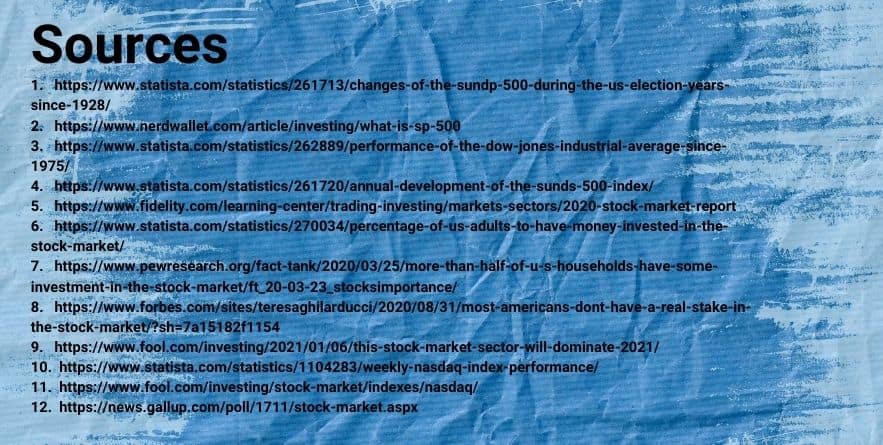Key Takeaways
- The stock market is a popular investment option for Americans, with over 50% of adults having money in the stock market in 2020.
- The technology sector has shown the best performance since 2019, and the biggest traded companies in this sector include Apple, Microsoft, and NVIDIA.
- The S&P 500 and the Dow Jones Industrial Average are indices that track the stock prices of big companies in the US, while the Nasdaq Composite tracks more than 3,000 Nasdaq-listed securities.
- In 2020, the stock market experienced both highs and lows due to the COVID-19 pandemic, but investors still had a good year.
Anyone who wants to grow their wealth should at least consider investing in the stock market. However, one thing to keep in mind is that there is a level of risk that you take on when you make this kind of investment, since the market fluctuates not only from one year to the next, but also within each day. Therefore, before you invest in stocks of any kind, it’s wise to do your research to learn about how it works and what you should anticipate.
How do people in the United States view the stock market and stock investments? And what are some of the interesting facts surrounding the performance of various stocks over the last few years?
Below, we take a look at several of the many fascinating stock market stats that showcase just how volatile the market can be, but also how it has grown over the years.
Top Statistics
- More than 50% of U.S. adults had money in the stock market in 2020.6,7
- In 2002, 67% of people in the U.S. owned stocks.8
- Since 2019, the technology sector has shown the best performance.9
- The biggest traded companies by market capitalization in the technology sector of the S&P 500 include Apple, Microsoft, Taiwan Semiconductor, NVIDIA, and Adobe.9
- According to Gallup, 12% of people relied on stocks as a major source of income in 2020.12
S&P 500 Statistics
The index known as the S&P 500 (short for Standard & Poor’s 500) looks at the top—you guessed it—500 companies across 11 sectors in the U.S. It has been around since 1860, and it tracks stock prices so you can get an idea of how the economy and the stock market are doing from one day to the next. And you can also use the S&P 500 to check on how particular industries are performing as well.1,2
- Even though the COVID-19 pandemic took a toll on the economy in 2020, the S&P 500 closed at the highest value that’s ever been recorded: 3,756.07 points.1
- The S&P 500’s average annual total return for nearly 100 years has been roughly 10%.2
- In 1990, the S&P’s value was 330.22. In the year 2000, it was 1,320.28. And in the year 2010, it was 1,257.64.2
- Consumer staples is considered a stock market sector that can withstand the effects of a recession. In 2008, when the financial crisis took hold, this sector performed better than the other 10 sectors.9
- The S&P 500 finished 2008 down by 37%.2
Dow Jones Statistics
Formed in 1985, the Dow, which is also known as the Dow Jones Industrial Average or DJIA, is an index that, like the S&P 500, consists of large companies in the U.S. However, there are far fewer, as it focuses on only 30. All of those companies are leaders in their industries.2,3
- At the end of 2020, the Dow’s value reached 30,606.48 points.3
- In 2019, the Dow registered a 28,538.33 high.3
- The Dow Jones Industrial Average took a hit in 2008 during the financial crisis. This was actually one of the index’s worst years, with some of the biggest losses on record.3
Nasdaq Statistics
Yet another index is the Nasdaq. And you can follow the Nasdaq Composite or the Nasdaq 100.
- At the end of 2020, the Nasdaq 100 was at 12,888.28 points.4
- In early April of 2021, the Nasdaq Composite index reached 13,688.84 points.10
- As of April in 2021, there were more than 3,000 Nasdaq-listed securities.11
- Some of the biggest stocks in the Nasdaq Composite include Apple, Microsoft, Amazon, Facebook, Alphabet Class C, Alphabet Class A, and Tesla.11
2020 Was a Year of Highs and Lows
Because of the COVID-19 pandemic, the stock market took a hit in 2020, but it also recovered surprisingly quickly. On the whole, investors managed to still have a good year despite the setbacks.5
- February and March of 2020 were particularly harsh, as U.S. stocks experienced the fastest decline on record: 20% or more.5
- 2020 showed some positive gains. For example, gold increased by around 28%, while global stocks went up by around 14%.5
- The tech sector was able to gain 41%, making 2020 the second year in a row that this sector gained more than 40%.5
- Sectors that finished the year 2020 with gains included Consumer Discretionary (30%), Communication Services (20%), Materials (17%), and Health Care (9%).5
- Sectors that finished 2020 with losses included Energy (-37%), Real Estate (-7%), Financials (-6%), and Utilities (-5%).5
- In 2020, because of the pandemic and a decrease in the demand for oil, its value dropped by 24%.5
How Americans View Stocks
Although many people might think of professional investors when they imagine the individuals who are buying and selling stocks every day, the truth is that a lot of regular consumers have also made it a point to put their money into the stock market in the hopes of watching it grow by a substantial amount.
- Prior to the Great Recession, in 2007, 65% of adults in the U.S. had money invested in the stock market.6
- The more income a household earns, the more money they have invested in the stock market. For example, the median holding for families earning more than $100,000 was around $138,700, while the median holding for families earning less than $35,000 was around $8,400, according to the Pew Research Center.7
- When compared to other types of investments, such as real estate, savings accounts/CDs, bonds, and gold, 21% of adults surveyed felt that stocks were the best long-term investment, according to Gallup.12
Overall, despite the many fluctuations that the stock market experiences, there has been plenty of growth over the last few years, and even the coronavirus pandemic wasn’t enough to keep stocks down for long. Only time will tell if the stock market continues to be just as resilient against any challenges that might lie ahead in 2023 and beyond.

To see our privacy policy click here.

